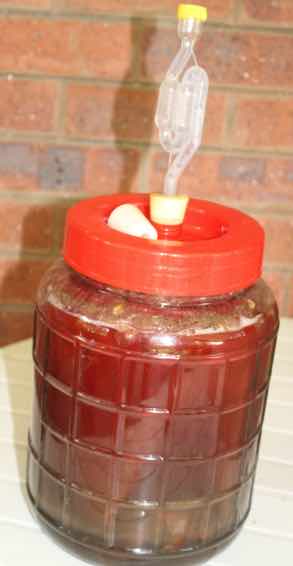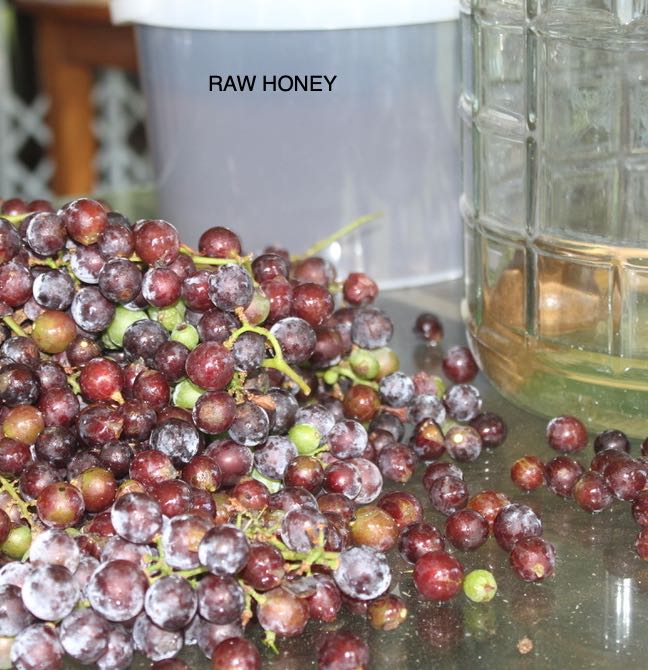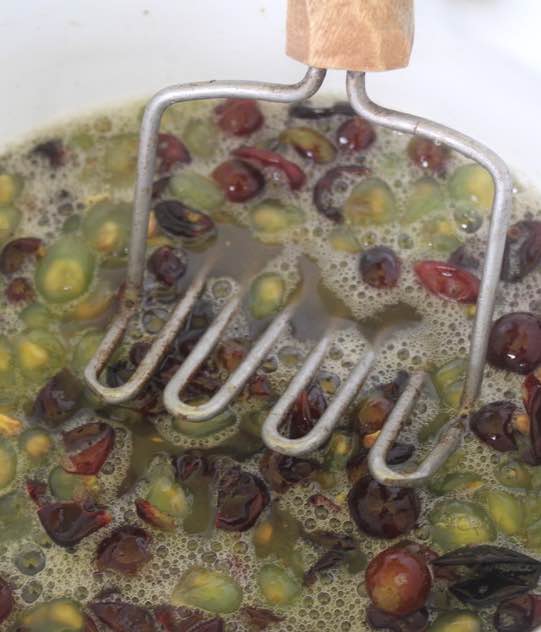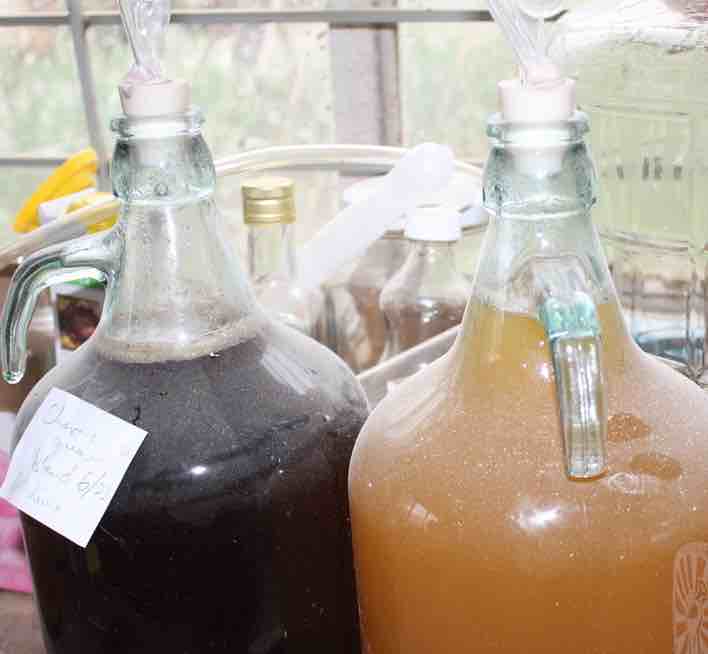- Bernard Preston homepage
- Honey Mead
- Catawba Grape Honey Mead
Catawba grape honey mead
Catawba grape honey mead is an excellent probiotic, rich in friendly yeast cells that contribute to the microbiome. It's a prime way to preserve fruit. There is a vast and seemingly growing weekly, research in the scientific literature currently about the importance of the bugs that live in the intestine; in fact in many parts of the body including the bladder and skin.
These colonies of friendly bacteria, viruses and yeast cells make a profound contribution to our wellness; one that we ignore at our peril.
The scientists are recommending we all spend more time making homemade probiotics like sauerkraut and kefir; they contain the broad spectrum of bugs that one simply cannot get from a pill.
A mead made with fruit is generally known as a melomel; if grapes are used then it's called a pyment.

Essential equipment
An experienced meader will have all sorts of equipment like pH meters, hydrometer and trays for sterilising the bottles. For a beginner one really needs as a minimum a wide-mouthed carboy, several demijohns and an automatic syphon; one can add the rest as the hobby grows on us and more money is available.
The approximate cost of this outlay is about R1000 or $50.
The real cost of brewing a catawba grape mead lies in the natural, unspoiled honey. One really needs to be a beekeeper; you won't find it on supermarket shelves. Or do you have a friend with a few hives in his back garden?

Ingredients
Ingredient
- Grapes
- Raw honey
- Honeycomb with pollen
- Black tea
- Unchlorinated water
- Yeast (Vin13)
23L
- 6kg
- 7.5kg
- Saucer-size
- 2 tsp
- Fill carboy
- 1/2 tsp
18L
- 4.7kg
- 5.9kg
- Smaller
- 1.5 tsp
- Fill
- 1/3 tsp
8L
- 2kg
- 2.6kg
- A third
- 1 tsp
- Fill
- 1/4 tsp
In 23 litres use 8kg of honey for a sweet mead.
6.9kg for a semi-dry.
That is roughly 1tsp of honey less per glass of 125ml; about 6g.
Go for it
- Wash out the carboy with clean water, sterilise for 1 hour with available powder and rinse thoroughly; allow to drain to remove the last traces of the chemicals.
- Rehydrate the yeast in half a cup of warm unchlorinated water for 20 minutes.
- Make a pot of black tea and allow to steep for 10 minutes; cool and pour into the carboy.
- Add honey to wide-mouthed carboy.
- Half fill the carboy with warm boiled-water; aerate vigorously for ten minutes[4].
- Pluck the ripe grapes from the bunches, discarding the stems; weigh, wash and mash.
- Prick any sealed cells in the honeycomb; it's for the fresh pollen in the main.
- Place the grapes, juice and a chunk of honeycomb full of fresh pollen into a muslin bag; add sterilised smooth river stones or marbles. Gently add to the carboy.
- Fill the carboy to about 5cm from the top with warm water.
- Stir and measure the pH and initial SG if you want to know the alcohol content at the end.
- Add the yeast.
- Fit the lid and air trap. Within 24 hours fermentation should start.
- SG = 1.130 (Generally called the Original Gravity; OG)
- pH = 2
- Date 3.02.2024
- Ambient temperature 27oC

Weight the bag down
The bag with fruit will tend to float out of the must, buoyed up by the honeycomb and carbon-dioxide bubbles produced by fermentation. You can add marbles or smooth river pebbles to weight the bag down. Do this gently remembering that if they fall to the bottom they could shatter the glass carboy.
Temperature
Since the Catawba grapes ripen in midsummer you will not have difficulty with the ambient temperature dropping too low. Vin13 is more tolerant of fluctuations in the weather.
Ideally use liquid honey so it dissolves quickly but never heat it.
Six weeks later
- Six weeks later fermentation should have stopped; you could leave it longer. Gently remove the bag of fruit and river pebbles, squeeze out any liquid and discard. Do not drop the bag!
- Syphon the must out into demijohns leaving the dead yeast cells at the bottom.
- Use a pipette or wine thief to taste.
- Measure the pH and SG.
- Fill the demijohn with a little sterilised water and honey; or combine and blend with another mead.
- Fermentation will continue slowly; use an air trap.
Six months later
Six months later, or longer you can bottle your Catawba grape honey mead. There is no necessity to do this; you could leave it in the carboys for decades. Label each one carefully. After a year or more it will certainly mature and taste better.
A sludge carboy
Most of us are reluctant to discard the sludge at the bottom of the container after racking off the must. Keep it in smaller glass bottles, adding eventually to a 5L carboy. These blended meads are often the very best.
Clarity
For show purposes and to impress your friends a beautifully clear mead after several rackings takes a lot of beating. But in fact a cloudy mead, still with active yeast cells is an excellent probiotic, contributing to the health of the gut and general wellness.
Some recipes call for the addition of an enzyme such as pectinase to help settle the sediment; another chemical so I personally don't really favour it.
Natural wines, beers and meads
There is alas strong research that even small amounts of commercial alcohol drunk regularly contribute to malignant tumours; even one glass of wine per week[1].
However in the 5 Blue Zones of the world they drink several glasses of natural wine with their meals daily; and live to vigorous and zestful old age. It's postulated that this may be because unpasteurised meads for example, unpreserved with sulphites make excellent probiotics.
So few people drink these natural wines and meads; no research has been done. It is assumed that it is the alcohol that is at fault. We suspect there is some other factor at work. We are suspicious of all chemical food additives. It's known that inorganic nitrites added to preserve meat cause Parkinson's disease; could the sulphites in wine be doing something similar?
Catawba grape honey mead
Catawba grape honey mead is another of the homemade natural wines. It will be a year or more before I can show you what it looks like. Patience is an essential virtue when it comes to brewing.
But once you have been at it for a year or more then you will have a row of demijohns to choose from.
 Cherry guava and peppadew meads
Cherry guava and peppadew meadsI wish I was a rich man; then I would have a dedicated meadery. When my ship comes in then my demijohns will not be covered with sawdust. Ach, you'll have to eat a peck o' dirt before ye die!
When browsing use right click and "Open Link in New Tab" or you may get a bad gateway signal.
Newsletter
Our newsletter is entitled "create a cyan zone" at your home, preserving both yourself and Mother Earth for future generations; and the family too, of course. We promise not to spam you with daily emails promoting various products. You may get an occasional nudge to buy one of my books.
Here are the back issues.
- Lifestyle and ideal body weight
- What are ultra-processed foods?
- Investing in long-term health
- Diseases from plastic exposure
- Intensive lifestyle management for obesity has limited value
- A world largely devoid of Parkinson's Disease
- The impact of friendly bacteria in the tum on the prevention of cancer
- There's a hole in the bucket
- Everyone is talking about weight loss drugs
- Pull the sweet tooth
- If you suffer from heartburn plant a susu
- Refined maize meal and stunting
- Should agriculture and industry get priority for water and electricity?
- Nature is calling
- Mill your own flour
- Bake your own sourdough bread
- Microplastics from our water
- Alternative types of water storage
- Wear your clothes out
- Comfort foods
- Create a bee-friendly environment
- Go to bed slightly hungry
- Keep bees
- Blue zone folk are religious
- Reduce plastic waste
- Family is important
- What can go in compost?
- Grow broad beans for longevity
- Harvest and store sunshine
- Blue zone exercise
- Harvest and store your rainwater
- Create a cyan zone at your home
Did you find this page interesting? How about forwarding it to a friendly book or food junkie? Better still, a social media tick would help.
- Bernard Preston homepage
- Honey Mead
- Catawba Grape Honey Mead
Address:
56 Groenekloof Rd,
Hilton, KZN
South Africa
Website:
https://www.bernard-preston.com